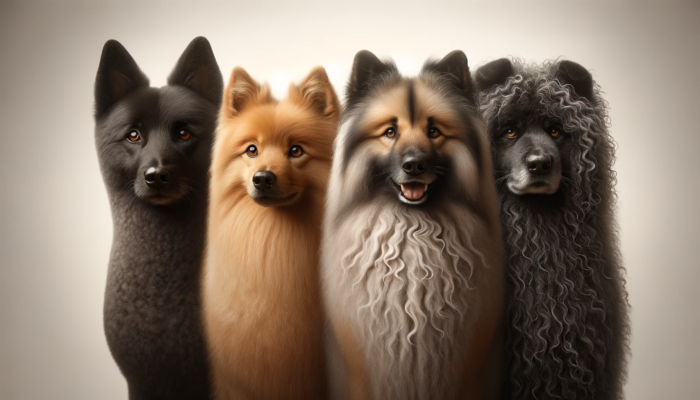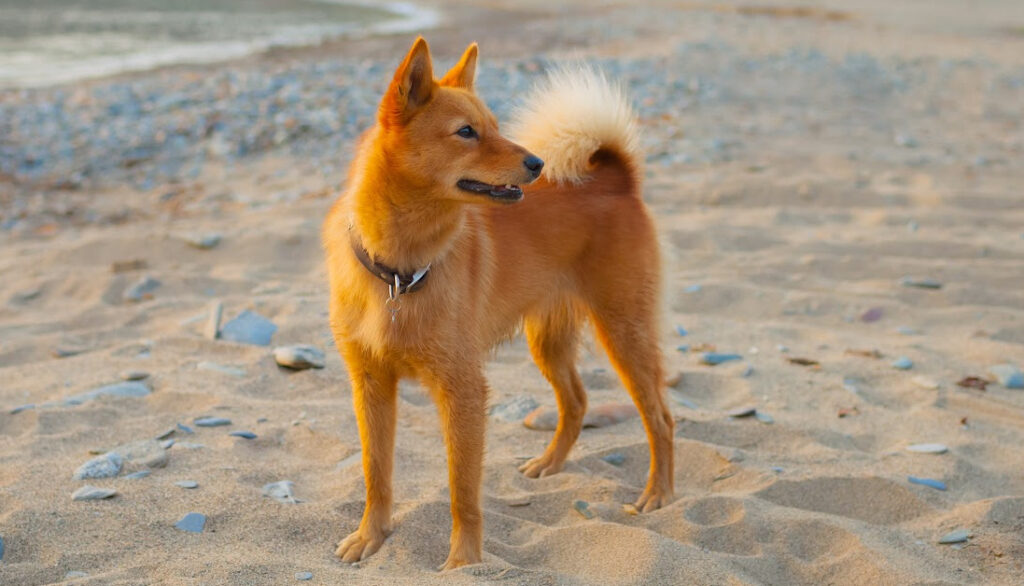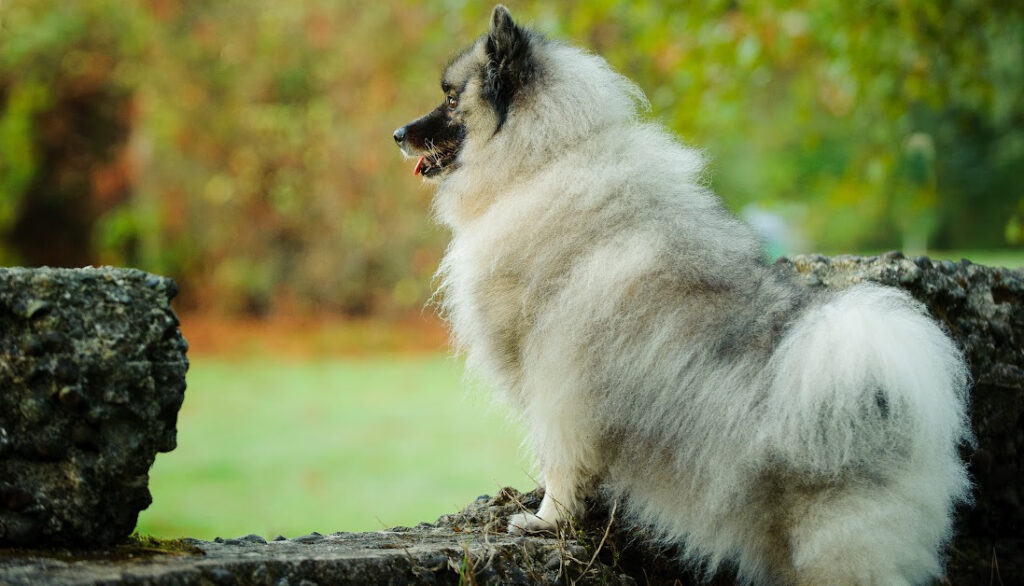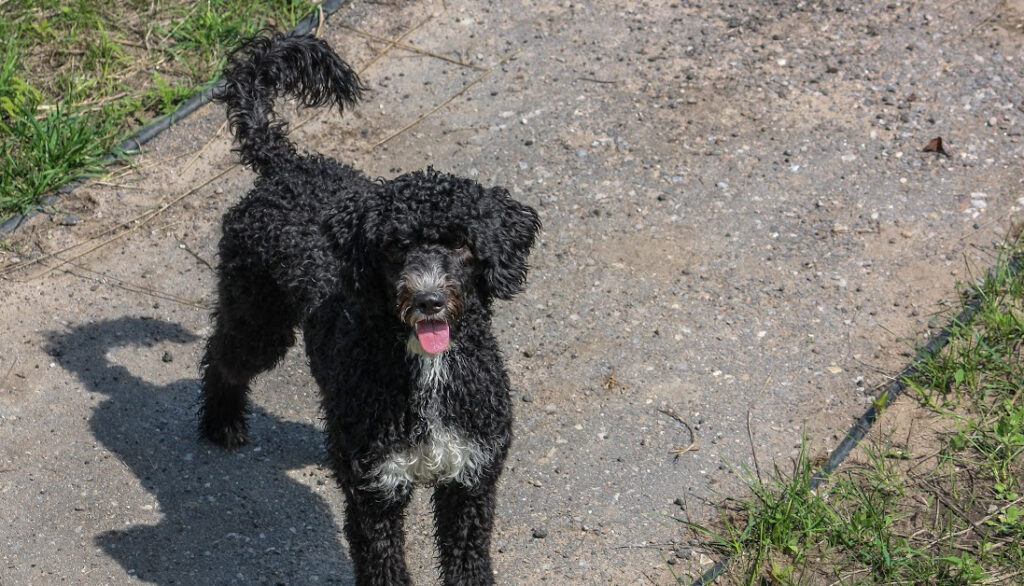Fellow dog lovers, who can resist the charm of a medium-sized dog with a curly tail? These unique canines capture our hearts with their adorable spiraled appendages, turning heads wherever they go. But beyond their cute and distinctive tails, these pooches have so much more to offer.

Medium-sized dogs with curly tails are often energetic, agile, and intelligent, making them perfect companions for active families or those looking for a pet with a little extra flair. They come in a variety of coat types, colors, and breed characteristics, so there’s a curly-tailed pal out there to match every lifestyle and personality.
So, what makes a dog’s tail curl? It might surprise you to know that a curly tail isn’t just a random quirk. Instead, it’s a feature shaped by both genetics and breed history. Over generations, dogs were selectively bred for specific traits, including tail shape. In some breeds, a curled tail helped keep the dog warm in cold climates, while in others, it was a sign of a good hunting or herding dog.
Now, let’s dive into the wonderful world of medium-sized dog breeds with curly tails. First on our list, the American Water Spaniel, a friendly and intelligent breed that loves to please. Don’t be fooled by their compact size; these dogs are hardy and versatile. Another breed that features a delightful curly tail is the Finnish Spitz. Known as the “barking bird dog” of Finland, this breed is lively and eager to please, with a cheerful personality that’s sure to win you over.

The Science Behind Curly Tails in Dogs
Have you ever wondered why some dogs have tails that curl up over their backs while others don’t? The answer is an exciting voyage into genetics, breed history, and evolution – a journey that can help you understand your furry friend even better. Let’s unravel the delightful puzzle of curly-tailed, medium-sized breeds together!
Genetic Factors Influencing Tail Curl
Genes play a significant role in dictating the shape and curl of a dog’s tail. These are the unseen architects that determine whether a dog’s tail curls up and over its back, in a ring, or perhaps a half curl. It’s a fascinating field of study, especially for those passionate about understanding their pup’s genetics.
Like most physical traits in dogs, the curl of a tail is decided by a series of genes, each with a dominant or recessive variant. If a dog inherits the dominant variant, they’ll have the trait associated with it – in this case, a curly tail. It’s an intriguing part of the genetic lottery that makes every dog unique!
However, it’s not just about the genes a dog inherits. Some breeds have variations within them, so you might find both curly-tailed and straight-tailed dogs within the same breed. That’s one of the magical things about medium-sized dog breeds with curly tails – the diversity can be astounding!
The Role of Breed History and Evolution
While genes are the blueprint, breed history and evolution are the builders. It’s essential to consider these factors because they often served a practical purpose in a dog’s ancestral role.
For instance, the curly tail of the Spitz breeds, which includes the Finnish Spitz and Norwegian Lundehund, helped them withstand harsh climates. The tail acted as a warm cover against snow when they curled up to sleep. Similarly, the curly tail of the Portuguese Water Dog helped it act as a rudder when swimming, demonstrating how every detail of a breed’s evolution is wonderfully functional.
Breed history also plays into this. Many breeds have been selectively bred over generations to maintain or enhance certain features, including tail curl. So, if a puppy from a breed known for its curly tail is born with a straight tail, it may be seen as a ‘fault’ – not fitting the breed standard.
Observing and understanding the curly tails of medium-sized dog breeds can be a fascinating journey into the world of genetics and breed evolution. It’s a testament to how every feature of your dog is a blend of careful selection by breeders and the beautiful randomness of genetics. And that’s part of the joy of being a dog parent – every day can be an opportunity to learn something new about your four-legged friend!
So next time you gaze at your curly-tailed pal, remember what a beautiful mystery you’re looking at. There’s a world of genetics, history, and evolution curled up in that tail – just another reason to marvel at the wonder of dogs!
Medium-Sized Dog Breeds with Curly Tails: A Curated List of Unique Twisted-Tail Pups
Dog lovers can attest that each breed has its own charm, but there’s something especially enchanting about medium-sized dog breeds with curly tails. These breeds add a quirky twist to the canine family, literally. If you’re considering bringing such a breed into your home, or if you’re simply intrigued by their curled tails, this list will provide an overview of two popular medium-sized breeds known for their distinctive tails: the American Water Spaniel and the Finnish Spitz.
American Water Spaniel
The American Water Spaniel is a breed that’s both versatile and charming, with their tail being one of the most identifiable characteristics. The tail curls up in a delightful twist, adding a unique look to this already adorable breed.
American Water Spaniels are medium-sized dogs, usually weighing between 25 and 45 pounds. They have a dense, waterproof coat that can vary from solid brown to a darker, almost chocolate shade. They are known for their intelligence and energy, making them great companions for active families.
These dogs have a history as working dogs, originally bred for hunting and retrieving in the Midwestern United States. This breed is known for being versatile on land and in water, a trait that’s reinforced by their name.
Care Requirements
The American Water Spaniel requires regular grooming due to its dense, curly coat. Brushing a few times per week will help to avoid matting and keep the coat looking its best. Being active dogs, they require plenty of exercise, including walks, playtime, and even swims, if possible.
Finnish Spitz
The Finnish Spitz, Finland’s national dog, is another charming medium-sized breed with a curly tail. These dogs have a fox-like appearance with a plush, golden-red coat and a tail that curves over their back.
Finnish Spitz dogs are known for their lively personalities, being both friendly and alert. They typically weigh between 20 and 30 pounds, fitting perfectly into the medium-sized category.
Breed History
This breed has a history as a hunting dog in its native Finland. They were used to hunt a variety of game, from squirrels to bears, with their sharp senses and agile bodies. Their reputation as skilled hunting dogs still holds today, although they are often kept as family pets.
Care Requirements
The Finnish Spitz requires regular brushing due to its dense double coat. This breed is also known for being somewhat vocal, so training may be necessary to control excessive barking. As with many other active breeds, regular exercise is a must to keep these dogs happy and healthy.
These are just two examples of medium-sized dog breeds with curly tails. Each breed has its own unique set of characteristics, care requirements, and history. Whether you’re looking for a new furry friend or simply curious about different dog breeds, knowing more about these curly-tailed pups can add to your canine knowledge.
The Pumi: A Spirited Medium-Sized Curly-Tailed Breed
When it comes to medium-sized dog breeds with curly tails, the Pumi often stands out. This breed, known for its distinctive curly tail and spirited temperament, is a favorite among dog owners worldwide.
Origin and History of the Pumi
Believed to have originated in Hungary, the Pumi is a herding breed designed to work livestock. Its ancestors include the Puli and German and French herding breeds, which were crossbred to produce the agile and intelligent Pumi we know today.
This breed boasts an adorable curly tail that often rests on its back, adding to its playful appearance. The Pumi’s curly tail isn’t just for looks; it’s a result of the dog’s genetic makeup, which has been passed down through generations. This breed, like many medium dogs with curled tails, inherited their unique tail from their parents, and the trait continues to be prevalent in the breed today.
Temperament and Care Requirements
The Pumi is known for its playful and energetic nature. These dogs have a natural instinct to herd, and as such, they need a good deal of exercise to stay happy and healthy. Regular walks, playtime in a fenced yard, or even dog sports can help ensure a Pumi gets the physical activity it needs.
In terms of care, the Pumi’s coat is a unique mix of wavy and curly hair that requires regular grooming to prevent matting. This medium-sized dog breed with a curly tail needs a bath every few weeks, and its coat should be brushed at least once a week.
Despite its playful nature, the Pumi is also known for its intelligence. It’s quick to learn and easy to train, making it a great option for first-time dog owners. However, like many other breeds, Pumis can sometimes be a bit stubborn, so consistency and patience during training sessions are key.
When you bring a Pumi into your home, you’re not just getting a medium-sized dog with a curly tail; you’re adding a lively and loving family member who will bring joy and energy into your life.
Remember, every dog is unique, and while breed can give you an idea of what to expect in terms of size, temperament, and care requirements, individual dogs within a breed can vary. Always ensure to spend time with a dog before bringing it into your home to ensure it’s the right fit for your family and lifestyle. With the right care and attention, a Pumi can make a wonderful addition to any household.

The Basset Fauve de Bretagne: A Rustic and Loyal Companion
When you think of medium-sized dog breeds with curly tails, the Basset Fauve de Bretagne might not be the first breed that comes to mind. Yet, this French hound with its distinctive wiry coat and tightly curled tail is a standout in the category.
Unique Features of the Basset Fauve de Bretagne
The Basset Fauve de Bretagne, also known as the Fawn Colored Brittany Basset, is a rare breed outside of its native France. This dog is known for its rustic appearance, with a dense, wiry coat that ranges from fawn to red. The breed’s most distinguishing feature, however, is its tightly curled tail, which gives it a unique, playful look.
These dogs have a strong, robust build and are known for their agility and endurance. They have expressive, dark eyes and their ears are medium in length, set high on the head, and turn slightly at the tips. Despite their medium size, these dogs are sturdy and well-built, making them excellent working dogs.
Exercise and Grooming Needs
The Basset Fauve de Bretagne is an active and energetic breed, requiring regular exercise to keep them happy and healthy. They love to explore and have a strong hunting instinct, so it’s essential to provide them with plenty of opportunities for physical and mental stimulation. A daily walk, along with time to run and play in a secure area, is ideal.
When it comes to grooming, the Basset Fauve de Bretagne is relatively low maintenance. Their wiry coat is designed to protect them from the elements and doesn’t require frequent bathing. However, regular brushing is necessary to keep their coat healthy and free from mats. Their curly tail, in particular, can be prone to tangling, so it’s essential to pay extra attention to this area during grooming sessions.
It’s also crucial to check their ears regularly, as their shape can make them prone to infection. Regular teeth cleaning and nail trimming should also be part of their grooming routine.
Final Thoughts
The Basset Fauve de Bretagne is a wonderful companion for those who appreciate a medium-sized dog with a curly tail and a robust, rustic appearance. They are loyal, friendly, and adaptable, making them suitable for a variety of homes. However, their high energy levels and exercise needs mean they are best suited to an active household where they can get plenty of physical and mental stimulation.
Remember, every dog is unique and has its own needs and preferences. Always take time to understand the specific needs of your chosen breed, and you’ll have a loyal, loving companion for life.
The Portuguese Water Dog: An Agile and Intelligent Curly-Tailed Breed
The Portuguese Water Dog, or “Portie” for short, stands out among medium-sized dog breeds with curly tails for its agility and intelligence. This breed boasts a proud heritage which has left it well-suited for various tasks and easy to train.
The Heritage of the Portuguese Water Dog
The Portuguese Water Dog has a rich history, tracing its roots back to the coast of Portugal. These dogs were bred to be sailors’ companions, helping to retrieve lost gear, deliver messages between ships, and even herd fish into nets. Their curly tails are thought to have been ideal for swimming, acting as a rudder in the water.
Today’s Porties retain their love for water and are recognized by their sturdy build, wavy or curly coats, and unmistakably curly tails. Standing between 17 to 23 inches tall and weighing 35 to 60 pounds, they are a perfect example of medium-sized dog breeds with curly tails.
Training and Socialization for Optimal Behavior
Portuguese Water Dogs are known for their intelligence and quickness to learn. They thrive on mental stimulation, making them responsive to training. Training should begin in puppyhood, and due to their working heritage, they particularly excel at obedience, agility, and water-based tasks.
One element to note about the Portie’s temperament is its propensity for “mouthiness”. This breed likes to explore their world with their mouth, which can lead to unwanted chewing or nipping. Early socialization and training can help manage this behavior, teaching them what is acceptable to chew on and how to interact gently with people.
Socialization is essential for Portuguese Water Dogs. They are a sociable and people-focused breed that enjoys being part of the family’s daily activities. Regular interaction with a variety of people and other animals will help to develop a sociable and well-rounded dog.
In terms of exercise, Portuguese Water Dogs are energetic and require regular exercise to keep them healthy and content. Daily walks, swimming sessions, and agility training are all great ways to ward off boredom and keep your Portie in excellent condition.
To sum up, the Portuguese Water Dog is a lovable, intelligent, and active breed, well-suited to families who can offer plenty of mental and physical stimulation. With its distinct heritage and lovable curly tail, a Portie could be the perfect addition to your family.
Remember, every dog is unique and can exhibit different characteristics, even within a breed. Therefore, it’s always crucial to get to know your potential canine companion thoroughly before deciding if they’re the right fit for your home and lifestyle.

The Keeshond: A Fluffy and Friendly Family Pet
If you’re seeking a medium-sized dog breed with a curly tail that’s both fluffy and friendly, the Keeshond could be the perfect pet for you. Known for their plush, silver-grey coat and tightly curled tail, Keeshonds make excellent family companions due to their friendly and outgoing nature.
The Distinctive Look of the Keeshond
What sets the Keeshond apart from other medium-sized dog breeds with curly tails is their distinct appearance. Their tail, in particular, is a standout feature. It’s tightly curled over the back, almost forming a complete loop. On top of this, their tail is generously covered with long, straight, harsh hair that adds to the overall fluffy look of the breed.
Keeshonds have a double coat with a dense woolly undercoat and a longer outer coat. This outer coat, combined with the hair on their tail, forms a beautiful ruff around their neck and shoulders, which gives them a lion-like appearance. Their eyes are dark, almond-shaped, and often have a mischievous sparkle – a sign of their playful and energetic personality.
Health and Wellness for a Keeshond
Like any dog breed, Keeshonds need regular exercise to keep them healthy and happy. They are an active and agile breed, loving walks, games of fetch, and even agility training. However, due to their thick coat, they can struggle in very hot weather, so it’s essential to provide them with plenty of shade and water during the summer months.
Keeshonds are generally healthy dogs, but they can be prone to certain breed-specific health issues. These include hip dysplasia, heart disease, and progressive retinal atrophy (PRA). Regular vet check-ups and a balanced diet can go a long way in ensuring your Keeshond lives a long and healthy life.
When it comes to grooming, Keeshonds require a bit more effort than some other breeds. Their thick double coat needs regular brushing to prevent matting and to keep it looking its best. Regular brushing is particularly important for their curly tails as the hairs can easily become tangled. But don’t let this deter you – Keeshonds are known to enjoy their grooming sessions, seeing it as another form of attention and affection.
In summary, if you’re looking for a medium-sized dog breed with a curly tail that’s friendly, fluffy, and full of character, the Keeshond could be the perfect addition to your family.
The Norwegian Lundehund: A Rare Breed with Unique Characteristics
The Norwegian Lundehund, also known as the Norwegian Puffin Dog, is an ancient breed with an abundance of unique features. Among these striking features is their curly tail, which adds to their appeal and makes them one of the fascinating medium-sized dog breeds with curly tails.
Understanding the Norwegian Lundehund’s Curly Tail
Unlike most dog breeds, the Lundehund’s tail does not simply curl at the end. Instead, it forms a tight ring that often rests over the dog’s back or hip. This curly tail is not just an aesthetic feature but serves a purpose as well.
The tail acted as a rudder when these dogs were used for puffin hunting on steep cliffs in their native Norway. The curl helped to improve their balance and agility when navigating the precarious terrains. The tail’s curl is an excellent example of how genetics and evolution work hand in hand to equip a breed with necessary survival tools.
Special Considerations for Norwegian Lundehund Owners
Being an owner of a Norwegian Lundehund is indeed a unique experience. However, alongside the joy and companionship these dogs bring, they also come with specific care and maintenance requirements.
- Exercise: These dogs are energetic and require regular exercise to keep them healthy and happy. A daily walk along with playtime is necessary to meet their physical needs.
- Diet: The Lundehund has a unique digestive system, which requires a specific diet. Your vet can guide you on the best diet plan for your pet.
- Grooming: Despite their double coat, Lundehunds are quite easy to groom. Regular brushing is sufficient to keep their fur in good condition. Their curly tails also require occasional cleaning and checking for any signs of parasites or infections.
- Health: This breed is prone to Lundehund Syndrome, a series of gastrointestinal disorders. Regular vet check-ups can help detect and manage this condition early.
Finally, remember that the Norwegian Lundehund is more than just a medium-sized dog with a curly tail. They are intelligent, alert, and extremely loyal pets. They thrive on companionship and love being part of the family activities.
Conclusion
The world of medium-sized dog breeds with curly tails is as fascinating as it is diverse. From the spirited Pumi to the unique Norwegian Lundehund, each breed carries its own stories, characteristics, and charm. As pet parents, understanding the needs of these breeds and providing them with love and care is our most rewarding job. Indeed, a curly-tailed companion is more than just a pet; they are family who fills our homes with joy, companionship and often, some tail-chasing fun!
Frequently Asked Questions
Q1: What are some medium-sized dog breeds with curly tails?
A: Some medium-sized dog breeds with curly tails include the Shiba Inu, Akita, Alaskan Malamute, and the Norwegian Elkhound.
Q2: Do all medium-sized dog breeds have curly tails?
A: No, not all medium-sized dog breeds have curly tails. The tail shape and size can vary greatly depending on the breed.
Q3: Does the curliness of a dog’s tail have any specific function?
A: Yes, the curliness of a dog’s tail can serve several functions. For example, in cold climates, dogs with curly tails can use their tails to cover their noses and keep warm. The curl can also aid in communication and balance.
Q4: Can a dog’s tail change from straight to curly as they grow?
A: Generally, a dog’s tail will not change from straight to curly as they grow. The shape of a dog’s tail is determined by its genetics and will typically remain the same throughout its life.
Q5: Are there any health issues associated with curly-tailed dog breeds?
A: Some curly-tailed dog breeds can be prone to certain health issues, such as spinal problems or issues with the vertebrae in the tail. However, these issues are not common in all curly-tailed breeds and can often be managed with proper veterinary care.
Dr. Candy, a holistic veterinarian and certified raw dog food nutrition specialist, graduated from Oklahoma State University in 2009 with a DVM and has since specialized in companion animal nutrition, advocating for species-specific diets. With a background in wildlife rehabilitation and oil spill response, she combines holistic health and conventional medicine in her unique approach to treating chronic diseases, allergies, and autoimmune conditions in pets. As the owner of a veterinary practice in Colorado and an author, Dr. Candy is dedicated to educating pet parents and improving the health and happiness of animals.




